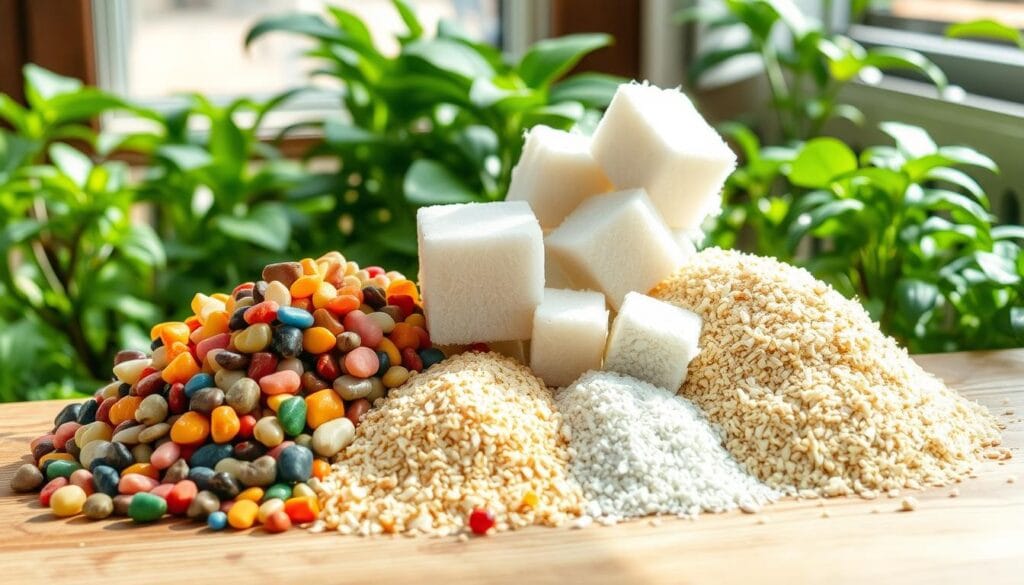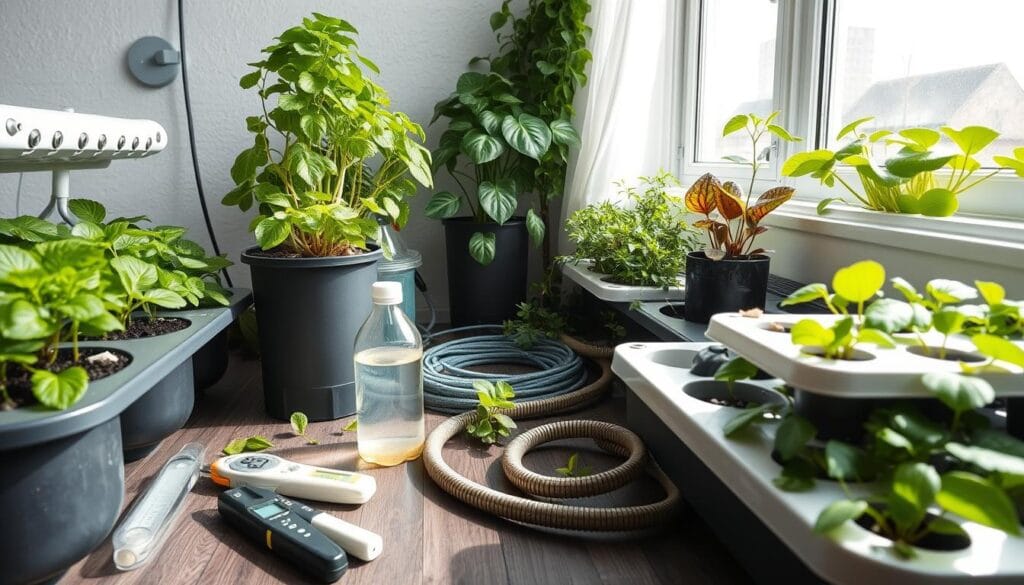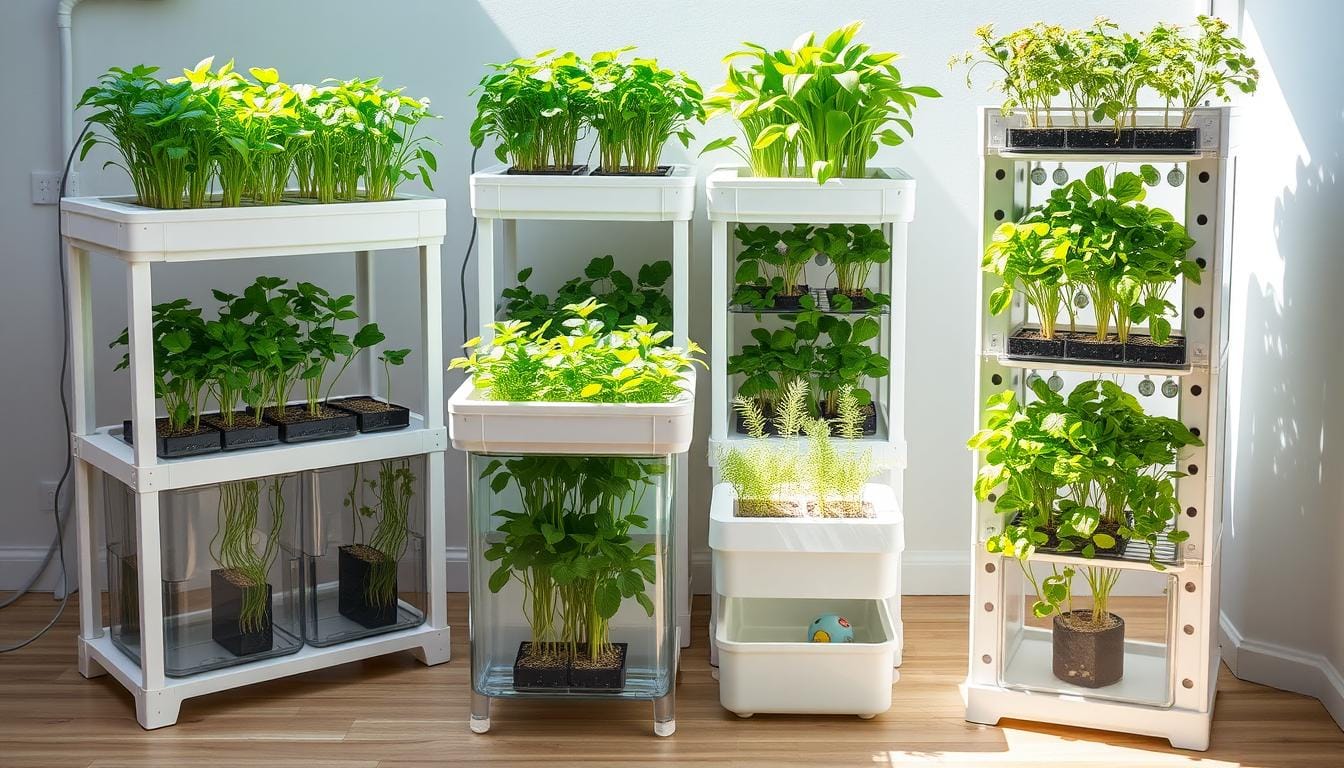Living in the city, I wanted to garden, even with a small apartment. Hydroponic gardening changed everything. It lets you grow fresh herbs, veggies, and flowers without soil. I was excited to make a green oasis in my home.
In this guide, I’ll show you how to make your own portable DIY hydroponic system. Whether you’re a beginner or an experienced gardener, it makes no difference. This article will help you turn your space into a lush, eco-friendly garden.
Key Takeaways
- Hydroponic gardening offers an efficient, space-saving solution for indoor cultivation.
- DIY hydroponic systems allow you to grow a variety of herbs, vegetables, and flowers year-round.
- Modular designs provide flexibility and customization options for your unique living space.
- Hydroponic systems conserve water and accelerate plant growth compared to traditional soil-based gardening.
- Building your own hydroponic system is a rewarding and sustainable hobby for urban dwellers.
Understanding Hydroponic Gardening Fundamentals
Hydroponic gardening grows plants without soil. It saves water, grows plants faster, and increases yields. Plants get nutrients directly, making it a controlled and efficient way to grow.
Benefits of Soilless Cultivation
Hydroponics significantly reduces water consumption, using up to 90% less water than conventional farming techniques. It also cuts down on pesticides, leading to healthier food. This method allows for year-round growth and faster plant growth.
Basic Principles of Hydroponics
Hydroponics delivers nutrients directly to the roots. This ensures plants get what they need for growth. It also helps with water and oxygen, keeping plants healthy and productive.
Water and Nutrient Circulation
The heart of hydroponics is the water reservoir. A pump keeps the nutrient solution flowing to the roots. The solution is then checked and adjusted to keep the right balance.
“Hydroponics stands as a versatile and enduring approach to water conservation and crop cultivation, providing a sustainable answer to the demands of modern agriculture.”
Essential Components and Materials Needed
To build a DIY hydroponic system, you need some key parts. These include a 27-gallon storage bin with a lid, PVC pipes and fittings, and net cups. You’ll also need aquarium silicone sealant, a submersible water pump, bulkheads, tubing, and plant nutrients.
Tools like hole saws, a paddle bit, and a hand saw are necessary. You’ll also need a measuring tape, a miter saw, a permanent marker, a power drill, and a reciprocating saw.
For the growing medium, choose between rockwool or hydroton clay pebbles. A pH testing kit is vital for checking the nutrient solution’s acidity. For indoor systems, LED grow lights are best for plant growth.
| Component | Purpose |
|---|---|
| 27-gallon storage bin with lid | Serves as the main container for the hydroponic system |
| PVC pipes and fittings | Constructs the framework and water delivery system |
| Net cups | Holds the plants and growing medium in place |
| Aquarium silicone sealant | Seals and waterproofs the system |
| Submersible water pump | Circulates the nutrient solution through the system |
| Bulkheads | Facilitates the water inlet and outlet connections |
| Tubing | Transports the nutrient solution throughout the system |
| Plant nutrients | Provides essential minerals for plant growth |
With these components, you can make a modular, self-assembly hydroponic system. It will have automated irrigation and great growing conditions for many plants.
Portable DIY Hydroponic System: Design Options
Building a portable DIY hydroponic system provides versatile design options. These customizable setups are ideal for growing leafy greens, herbs, or small vegetables in limited spaces.
Wick System Design
The wick system is straightforward and effortless to install. It uses a soda bottle, twine or absorbent material, and coco coir or perlite. The wick pulls nutrient-rich water up to the roots, no pumps or electricity needed.
Deep Water Culture Setup
In a deep water culture (DWC) system, roots hang in nutrient-rich water. An air pump adds oxygen, helping roots absorb nutrients. It’s great for leafy greens and herbs, and can be adjusted to fit your space.
Nutrient Film Technique
The nutrient film technique (NFT) has a continuous flow of solution over roots. Plants are in channels or tubes, with solution always moving. This setup is efficient, using less water and nutrients while keeping plants supplied.
Each modular hydroponic design has its own benefits. They can be tailored for different plants and spaces. By learning about these systems, you can create a hydroponic setup that fits your needs.
| Hydroponic System | Key Features | Ideal Plants | Space Requirements |
|---|---|---|---|
| Wick System | Simple setup, no electricity needed | Herbs, leafy greens | Compact, can fit on a countertop |
| Deep Water Culture | Oxygenated water, easy to maintain | Leafy greens, herbs | Flexible, can be scaled up or down |
| Nutrient Film Technique | Efficient water and nutrient usage | Leafy greens, herbs, small vegetables | Can be designed for limited spaces |
Building Your Basic Structure
Building the base of your DIY hydroponic setup is key. Start by putting together the main structure with PVC pipes and fittings. Make sure to cut holes in the storage bin lid for your net cups. This guarantees a secure and leak-proof connection.
Install bulkheads for water flow in your setup. If you need grow lights, build a strong frame to hold them. Make sure all connections are tight and waterproof. Use silicone sealant to prevent leaks. Sand any rough edges to protect your tubing and plant roots.
By carefully building your structure, you lay a solid base for your DIY hydroponic system. This modular design makes it easy to change and grow as you need. With a strong foundation, you’re ready to move on to the next steps in your hydroponic journey.
| Hydroponic System | Pros | Cons |
|---|---|---|
| Vertical Hydroponics | Allows for growing more plants in less space | Requires careful design for even nutrient distribution |
| Nutrient Film Technique (NFT) | Extremely water-efficient, supports high plant density | Requires careful setup for proper flow rate, prone to clogging |
| ZipGrow Towers | Simple setup and maintenance, scalable design | More expensive than DIY options, may need supplemental lighting |
| Stacked Systems | Highly customizable, easy scaling, fun DIY project | Requires careful design for even nutrient distribution |
The success of your DIY hydroponic setup depends on the modular construction. By adhering to these guidelines, you’ll establish a reliable base. This sets the stage for a thriving and productive hydroponic garden.
Setting Up the Irrigation System
Creating a good irrigation system is key to a successful DIY hydroponic setup. You’ll need a submersible pump, tubing, and a smart layout. This ensures water moves well through your grow trays or net pots.
Pump Installation Guide
Start by putting the submersible pump in your reservoir. Make sure it’s safe and fully in the water. This keeps it working well and avoids damage. Also, keep the power cord away from the water.
Tubing and Connection Layout
Next, connect the tubing from the pump to your grow trays or net pots. Place the tubing to spread water evenly and avoid kinks. Using a manifold or multiple outlets helps with even flow.
Water Flow Testing
After setting up, test the water flow. Turn on the pump and watch the water move. Adjust the flow to keep it even and prevent still spots. Also, check for leaks and fix them right away.
Good water flow stops algae and keeps roots healthy in your hydroponic plants. By following these steps, you’ll have a reliable irrigation system for your plants to grow well.
| Component | Description | Importance |
|---|---|---|
| Submersible Pump | Responsible for circulating the nutrient solution through the system. | Ensures consistent water flow and distribution. |
| Tubing | Connects the pump to the grow trays or net pots, facilitating water movement. | Proper tubing layout is crucial for even water circulation. |
| Water Flow Testing | Checking the system for proper water flow and any potential leaks or obstructions. | Helps optimize the irrigation system and prevent issues like algae growth or root rot. |
Growing Medium Selection and Preparation
In the world of soilless cultivation, the growing medium is key to success. There are many options for different plant needs and preferences.
Rockwool is a mineral-based material that holds water well and allows for good aeration. Perlite is a volcanic rock that’s light and porous. It helps with drainage and air around the roots.
- Rockwool is great for holding water and air, making it versatile for many plants.
- Perlite is light and porous, perfect for drainage and air around the roots.
- Coconut coir, from coconut husks, is a natural fiber. It holds water well and keeps pH balanced.
It’s important to prepare your growing medium before use. Soak it in pH-balanced water until it’s fully saturated. Then, place it in net cups or grow trays for your plants.

Remember, plants have different preferences for growing mediums. Research the best medium for your plants. This can greatly affect their growth and health.
Nutrient Solution Management
Keeping your hydroponic garden’s nutrient solution right is key. It’s all about the right pH levels and a balanced nutrient mix for your plants to grow well.
pH Balance Monitoring
It’s important to keep the pH of your solution between 5.5 and 6.5. This helps your plants absorb nutrients better. Use a pH testing kit or meter to check levels and adjust as needed.
Essential Nutrients Mix
Your nutrient solution needs a mix of nitrogen, potassium, phosphorus, and trace minerals. Follow the maker’s guide to create a mix that meets your plants’ needs.
Solution Maintenance Schedule
Change the whole nutrient solution every two weeks. This keeps your plants getting fresh, concentrated nutrients. Also, keep the water between 65-75 degrees Fahrenheit for best plant health.
| Nutrient Solution Management Practices | Benefits |
|---|---|
| Consistent pH Monitoring and Adjustment | Ensures optimal nutrient uptake for healthy plant growth |
| Balanced Nutrient Mix | Provides plants with all the essential elements for vigorous development |
| Bi-weekly Nutrient Solution Replacement | Maintains proper nutrient concentration and prevents nutrient depletion |
| Optimal Water Temperature | Supports ideal growing conditions for hydroponic plants |
With a good nutrient solution management plan, your hydroponic garden will thrive. Regular pH checks, nutrient mix adjustments, and solution changes will help your plants succeed.
System Maintenance and Troubleshooting
Keeping your hydroponic system healthy needs regular care and quick problem-solving. Clean and check all parts often to keep your hydroponic system running well. Watch your plants for any problems like yellow leaves or slow growth. Fix nutrient issues fast by changing the solution.
Stopping algae is key to a healthy system. Keep light out of the nutrient solution and use air stones or water flow to add oxygen. Fix common problems like bad water flow, nutrient shortages, or pests quickly. Use a methodical way to problem-solving.
| Maintenance Task | Frequency | Benefits |
|---|---|---|
| Clean system components | Monthly | Prevents buildup and ensures optimal performance |
| Monitor plant health | Weekly | Early detection of issues for timely intervention |
| Adjust nutrient solution | As needed | Maintains optimal pH and nutrient levels for plant growth |
| Oxygenate water | Continuous | Supports root health and prevents anaerobic conditions |
Stay alert and fix problems fast to keep your hydroponic system thriving. Regular upkeep and quick troubleshooting lead to great results with this new way of growing.

“Hydroponic systems offer unparalleled control over the growing environment, allowing for optimal nutrient delivery and increased yields.”
Conclusion
Building your own DIY hydroponic system is a smart way to garden. It lets you grow many plants all year round. Plus, it saves water and other resources.
With the right setup and care, your hydroponic garden will give you lots of fresh, healthy food. You can grow it all in your home.
This guide showed you how to make your hydroponic system fit your needs and space. You can choose from different setups like wick-based or deep water culture. The key is to keep the water flowing, manage nutrients, and control the environment.
Using hydroponics lets you try new things and learn about plants and resources. It’s a fun and rewarding journey. So, start now and enjoy your DIY hydroponic garden.

